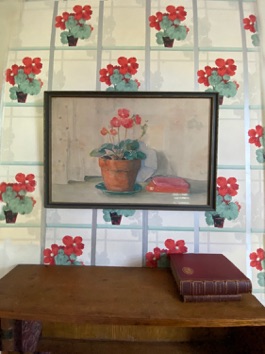Madeline Goodfriend (Schonberger)
Untitled, Single Red Flower with Books
Watercolor on paper 14” x 18 1/2” 1920’s
framed, on United Wall Paper Inc. “Single Red Flower”
Goodfriend’s watercolor made while a student at Pratt (circa 1928): her daughters recollected their Mother’s amusement of the resemblance to the wallpaper pattern when she and her husband Martin considered purchasing the Cottage.
An illustration that the world is full of chance (or destined) happenings or merely coincidence.
“Single Red Flower” (United Wallpaper Inc. co) wallpaper was one of three floral designs (surviving) thought to have been chosen to “re-decorate” the Cottage by Flocee Real Estate developer Ceravalo.
Reflecting popular motifs, in this instance following decades of development replacing native flora and fauna after lands were seized from Shinnecock Indian Nation (1859) to make way for the railroad. Reflecting the Colonialists belief of human domination over the natural world; the survival of nature dependent on human(e) care: in this instance being potted, brought indoors. Following death, preserved under glass.
Sited on lands clear cut to make way for LIRR service to Shinnecock Hills attracted real estate investors including LIRR president Austin Corbin, Real Estate developer and Railroad lawyer Samuel L. Parrish, and E. Boudinot Colt (husband of Jane Borrowe Colt).
copyright © 2021 Hope Sandrow all rights reserved


